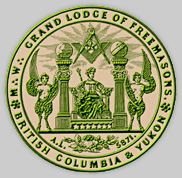|
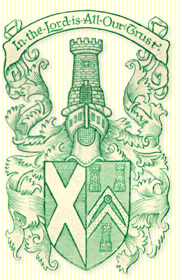 Grand Lodge of Scotland arms.
Grand Lodge of Scotland arms.
|
|
The seal of the Grand Lodge of British Columbia was adopted at a meeting held in Victoria on 27 December 1871: "That the seal of the District Grand Lodge E. R. be altered as to suit this Grand Lodge, and be adopted as the seal of the Grand Lodge of British Columbia." The Grand Treasurer's report for 1872 notes the expenditure of $15 on 19 February 1872 to E. Watson Engraving, and an additional $13 on 9 March 1872 to L. Curtis Engraving, but nothing is known of the seal's illustrator, and no record remains of its devising.
|
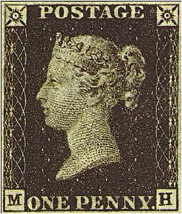 First British postage stamp, April 27 1840.
First British postage stamp, April 27 1840.
|
The central figure is either "Wisdom" personified, or Queen Victoria1, holding a scepter and orb, and wearing what appears to be either the small gothic tiara, set with square and kite-shaped sapphires, designed for her by Prince Albert in 1842, or the State Diadem she wore for her coronation on 28 June 1838. This was a common image, used for many years, originally on the first postage stamp, the Penny Black released for sale 6 May, 1840.2 It was based upon an engraving by William Wyon featuring the head of a young Queen Victoria, originally produced for the City of London medal. Although both the actual Grand Lodge seal and an engraving of the seal made in 1871 depict a tiara, during the 1990s the seal, based on an illustration appearing on this jurisdiction's lodge warrants, depicted something akin to a soft fabric cap or upswept hairstyle.
The throne is resting on a platform on which is drawn seven five-pointed stars; seven being a significant number in masonic tradition, referring either to the number required to open a lodge of freemasons, or the seven liberal arts and sciences—which are said to be the foundation of Freemasonry. Some masonic authors have suggested that the five-pointed star, or pentagram, refers to both Pythagoras and the Golden Ratio.
|
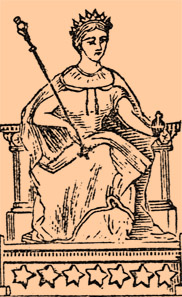 Detail from 1871 Grand Lodge seal.
Detail from 1871 Grand Lodge seal.
|
The seven stars found in engravings of the seal from 1871 onward do not appear in the original hand stamp used by the Grand Secretary in the 1870s and 1880s, and currently on display in the Grand Lodge museum.
Above Victoria is depicted a square and compasses which, in masonic symbolism refers to the freemason's duty to the Craft and to himself. Within the square and compasses is the pentalpha of Pythagoras or, as is commonly termed, the five-pointed star, identified by some masonic writers with the masonic five points of fellowship. Around the square and compasses is a glory of radiating lines.
On either side of the throne are pillars surmounted by globes, illustrating the pillars at the porch or entrance to King Solomon's Temple as first described in the Geneva Bible of 1560.
Flanking them are cherubim, denoted by Thomas Aquinas in Summa Theologica as the second order of angels described in Exodus 23:18-20 and Ezekiel 1:10, amongst others. 3
|
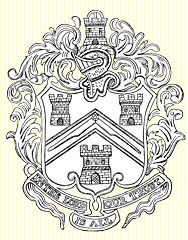 London Company of Masons.
London Company of Masons.
|
Below is an English red rose, intended to be emblematic of the homeland of this jurisdiction's first Grand Master, Israel Wood Powell—who was actually born in Wales but raised in England. The date is in the traditional masonic style, "A.L. 5871" Anno Latomorum (in the year of Masonry).
This is all surrounded by a collar bearing the title of the Grand Lodge of British Columbia. Surprisingly, there is no reference made to the union in this jurisdiction with the lodges warranted by the Grand Lodge of Scotland. No thistle is depicted. It may also be noteworthy that nothing was taken from the Premier Grand Lodge seal (1732).
|
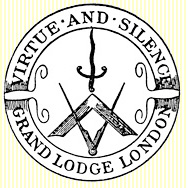 First seal of Antient Grand Lodge.
First seal of Antient Grand Lodge.
|
The square and compasses were taken from the first Ancient Grand Lodge seal, but turned upside down and both legs of the compasses placed above the square. From the second Antient Grand Lodge seal (1775), engraved by John Kirk (1724?-1778?), and from the third and last (1792), were taken the cherubim, with their gender retained but their raised wings reversed and their hair shortened. In both the first (1815-1920) and current (1920 - ) seals of the United Grand Lodge of England the cherubim are male.
|
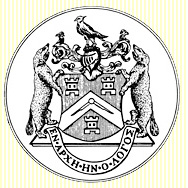 First seal of the Premier Grand Lodge.
First seal of the Premier Grand Lodge.
|
The Premier Grand Lodge of England, established in 1717, took for its seal the coat of arms granted to the London Company of Masons in 1472. "Sable or black on a chevron, between three towers argent or silver, a pair of compasses." The helm and castle illustration above the arms is not a part of the arms and Lau. Dermott substitutes an arm holding a trowel.
Of the four Canadian Grand Lodges4 constituted before British Columbia—except Nova Scotia which took its own design—all followed the United Grand Lodge of England design of quartered shield and cherubim, and latin motto enscrolled: Audi Vide Tace (hear, see, and be silent).
The cherubim embody multiple masonic significances. They are identified in Genesis 3:24 with a flaming sword guarding the tree of life, symbolized in masonic lodges by the Tyler's wavy sword. Exodus 25:18 records that two gold cherubim guarded the Ark of the Covenant in Solomon's Temple, further connecting them with masonic tradition.
A popular tradition reported in Ezekiel 1:5-28 described seraphim as having four faces—that of a lion, an ox, an eagle, and a man—and combined features of these four creatures, the stature and hands of a man, the hooved feet of a calf, and two pairs of wings.
|
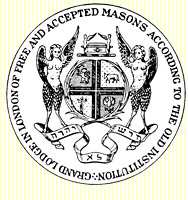 Final seal of Antient Grand Lodge.6
Final seal of Antient Grand Lodge.6
|
The lion, ox, eagle and man were also claimed by Laurence Dermott as the standards of the four principal tribes of Israel, Judah, Reuban, Dan and Joseph5 and were depicted on the seal of the Ancient Grand Lodge. But Numbers 2 lists the principal tribes as Judah on the east, Reuben on the south, Ephraim on the west, and Dan on the North, while their attributes are described in Genesis. Reuben, is "unstable as water" (Genesis 49:3), Judah "is a lion's whelp" (Genesis 49:9) and "Dan shall be a serpent by the way, an adder in the path, that biteth the horse heels" (Genesis 49:17). Ephraim is not mentioned at all.
The four figures are in fact taken from Revelation 7—"And the first beast was like a lion, and the second beast like a calf, and the third beast had a face as a man, and the fourth beast was like a flying eagle."—where early Ch�ristians interpreted them as symbols of the four Evangelists.
The seal of the Grand Lodge of British Columbia remained unchanged until 2000 when the title on the collar was changed to the M...W... Grand Lodge of British Columbia and Yukon.
1. Queen Victoria is claimed without citation in an undated monograph by RW Bro. Bill Robinson, Grand Historian 1990-2005, BC&Y Archives. In his 1998 report to Grand Lodge, he describes the figure as "Wisdom".
2. Queen Victoria is claimed without citation in an undated monograph by RW Bro. Bill Robinson, Grand Historian 1990-2005, BC&Y Archives. In his 1998 report to Grand Lodge, he describes the figure as "Wisdom".
2. Printed by engraver and inventor, Jacob Perkins (1766/07/09-1849/07/30), who received his masonic degrees on 10, 15 June 1794. [10,000 Famous Freemasons, Denslow, p. 328].
4. Printed by engraver and inventor, Jacob Perkins (1766/07/09-1849/07/30), who received his masonic degrees on 10, 15 June 1794. [10,000 Famous Freemasons, Denslow, p. 328].
4. Canada (1855), Nova Scotia (1866), New Brunswick (1867), Quebec (1869)
5. Canada (1855), Nova Scotia (1866), New Brunswick (1867), Quebec (1869)
5. Ezekiel 1:10 (King James Version) As for the likeness of their faces, they four had the face of a man, and the face of a lion, on the right side: and they four had the face of an ox on the left side; they four also had the face of an eagle. Also see Genesis 3:24; Ezekiel 28:14, Ephesians 1:21, Colossians 1:16 and Isaiah 6:2. Reuben is associated with the Water Bearer, which, of all the zodiac constellations, has the figure of a man. Judah is a lion's whelp" (Gen. 49:9), Dan shall be a serpent...that biteth the horse heels" (Gen. 49:17), and Joseph is compared to a wild ox in Deut. 33:17). How Dan went from being represented by a serpent to an eagle is a separate study. Note Genesis 49:9, "Judah is a lion's whelp" ; Deuteronomy 33:22, "And of Dan he said, Dan is a lion's whelp" ; Numbers 2 6. (25-31) where the standard of Dan is said to be an eagle. The eagle is also a symbol of Saint John, who is denoted a patron saint of Freemasonry. Compare with Revelation 4:7, "And the first beast was like a lion, and the second beast like a calf, and the third beast had a face as a man, and the fourth beast was like a flying eagle." Also see : Aben Ezra (1092- Jan. 28, 1167), Monatsschrift, xlii. 23, Naples: 1488, and Lekket Shikchah for a description of the standards.
6. Ezekiel 1:10 (King James Version) As for the likeness of their faces, they four had the face of a man, and the face of a lion, on the right side: and they four had the face of an ox on the left side; they four also had the face of an eagle. Also see Genesis 3:24; Ezekiel 28:14, Ephesians 1:21, Colossians 1:16 and Isaiah 6:2. Reuben is associated with the Water Bearer, which, of all the zodiac constellations, has the figure of a man. Judah is a lion's whelp" (Gen. 49:9), Dan shall be a serpent...that biteth the horse heels" (Gen. 49:17), and Joseph is compared to a wild ox in Deut. 33:17). How Dan went from being represented by a serpent to an eagle is a separate study. Note Genesis 49:9, "Judah is a lion's whelp" ; Deuteronomy 33:22, "And of Dan he said, Dan is a lion's whelp" ; Numbers 2 6. (25-31) where the standard of Dan is said to be an eagle. The eagle is also a symbol of Saint John, who is denoted a patron saint of Freemasonry. Compare with Revelation 4:7, "And the first beast was like a lion, and the second beast like a calf, and the third beast had a face as a man, and the fourth beast was like a flying eagle." Also see : Aben Ezra (1092- Jan. 28, 1167), Monatsschrift, xlii. 23, Naples: 1488, and Lekket Shikchah for a description of the standards.
6. The United Grand Lodge of England arms were derived from the standards of the four principal tribes of Israel. See AQC, vol 83 1970 p. 376-77. London Masons Company seal. AQC, vol 83 1970, p. 375. First Antient Grand Lodge arms. AQC, vol. 82, 1969, p. 240. Third Antient Grand Lodge arms. AQC, vol. 82 p. 241.
The United Grand Lodge of England arms were derived from the standards of the four principal tribes of Israel. See AQC, vol 83 1970 p. 376-77. London Masons Company seal. AQC, vol 83 1970, p. 375. First Antient Grand Lodge arms. AQC, vol. 82, 1969, p. 240. Third Antient Grand Lodge arms. AQC, vol. 82 p. 241.
|
|
 Grand Lodge of Scotland arms.
Grand Lodge of Scotland arms.
![[Grand Lodge]](../../images/hedn.jpg)
